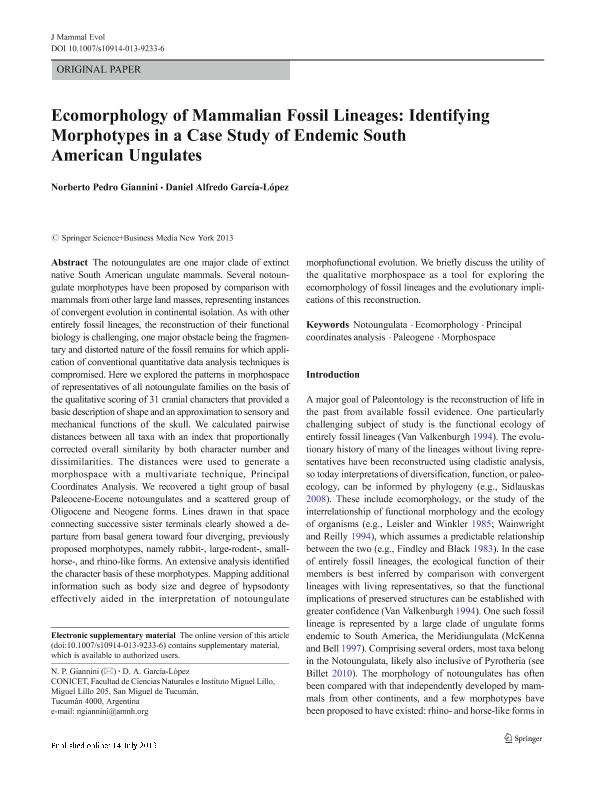Mostrar el registro sencillo del ítem
dc.contributor.author
Giannini, Norberto Pedro

dc.contributor.author
Garcia Lopez, Daniel Alfredo

dc.date.available
2017-01-02T15:47:23Z
dc.date.issued
2013-06
dc.identifier.citation
Giannini, Norberto Pedro; Garcia Lopez, Daniel Alfredo; Eco-morphology of Mammalian Fossil Lineages: Identifying Morphotypes in a Case Study of Endemic South American Ungulates; Springer; Journal of Mammalian Evolution; 21; 2; 6-2013; 195-212
dc.identifier.issn
1064-7554
dc.identifier.uri
http://hdl.handle.net/11336/10673
dc.description.abstract
The notoungulates are one major clade of extinct native South American ungulate mammals. Several notoun- gulate morphotypes have been proposed by comparison with mammals from other large land masses, representing instances of convergent evolution in continental isolation. As with other entirely fossil lineages, the reconstruction of their functional biology is challenging, one major obstacle being the fragmen- tary and distorted nature of the fossil remains for which appli- cation of conventional quantitative data analysis techniques is compromised. Here we explored the patterns in morphospace of representatives of all notoungulate families on the basis of the qualitative scoring of 31 cranial characters that provided a basic description of shape and an approximation to sensory and mechanical functions of the skull. We calculated pairwise distances between all taxa with an index that proportionally corrected overall similarity by both character number and dissimilarities. The distances were used to generate a morphospace with a multivariate technique, Principal Coordinates Analysis. We recovered a tight group of basal Paleocene-Eocene notoungulates and a scattered group of Oligocene and Neogene forms. Lines drawn in that space connecting successive sister terminals clearly showed a de- parture from basal genera toward four diverging, previously proposed morphotypes, namely rabbit-, large-rodent-, small- horse-, and rhino-like forms. An extensive analysis identified the character basis of these morphotypes. Mapping additional information such as body size and degree of hypsodonty effectively aided in the interpretation of notoungulate morphofunctional evolution. We briefly discuss the utility of the qualitative morphospace as a tool for exploring the ecomorphology of fossil lineages and the evolutionary impli- cations of this reconstruction.
dc.format
application/pdf
dc.language.iso
eng
dc.publisher
Springer

dc.rights
info:eu-repo/semantics/openAccess
dc.rights.uri
https://creativecommons.org/licenses/by-nc-sa/2.5/ar/
dc.subject
Notoungulata
dc.subject
Ecomorphology
dc.subject
Principal Coordinates Analysis
dc.subject
Paleogene
dc.subject
Morphospace
dc.subject.classification
Paleontología

dc.subject.classification
Ciencias de la Tierra y relacionadas con el Medio Ambiente

dc.subject.classification
CIENCIAS NATURALES Y EXACTAS

dc.title
Eco-morphology of Mammalian Fossil Lineages: Identifying Morphotypes in a Case Study of Endemic South American Ungulates
dc.type
info:eu-repo/semantics/article
dc.type
info:ar-repo/semantics/artículo
dc.type
info:eu-repo/semantics/publishedVersion
dc.date.updated
2016-12-28T16:30:26Z
dc.journal.volume
21
dc.journal.number
2
dc.journal.pagination
195-212
dc.journal.pais
Alemania

dc.journal.ciudad
Berlin
dc.description.fil
Fil: Giannini, Norberto Pedro. Consejo Nacional de Investigaciones Científicas y Técnicas; Argentina. Universidad Nacional de Tucumán. Facultad de Ciencias Naturales e Instituto Miguel Lillo; Argentina
dc.description.fil
Fil: Garcia Lopez, Daniel Alfredo. Universidad Nacional de Tucumán. Facultad de Ciencias Naturales e Instituto Miguel Lillo; Argentina. Consejo Nacional de Investigaciones Científicas y Técnicas. Centro Científico Tecnológico Tucumán. Instituto Superior de Correlación Geológica; Argentina
dc.journal.title
Journal of Mammalian Evolution

dc.relation.alternativeid
info:eu-repo/semantics/altIdentifier/url/http://link.springer.com/article/10.1007%2Fs10914-013-9233-6
dc.relation.alternativeid
info:eu-repo/semantics/altIdentifier/url/http://dx.doi.org/10.1007/s10914-013-9233-6
Archivos asociados
